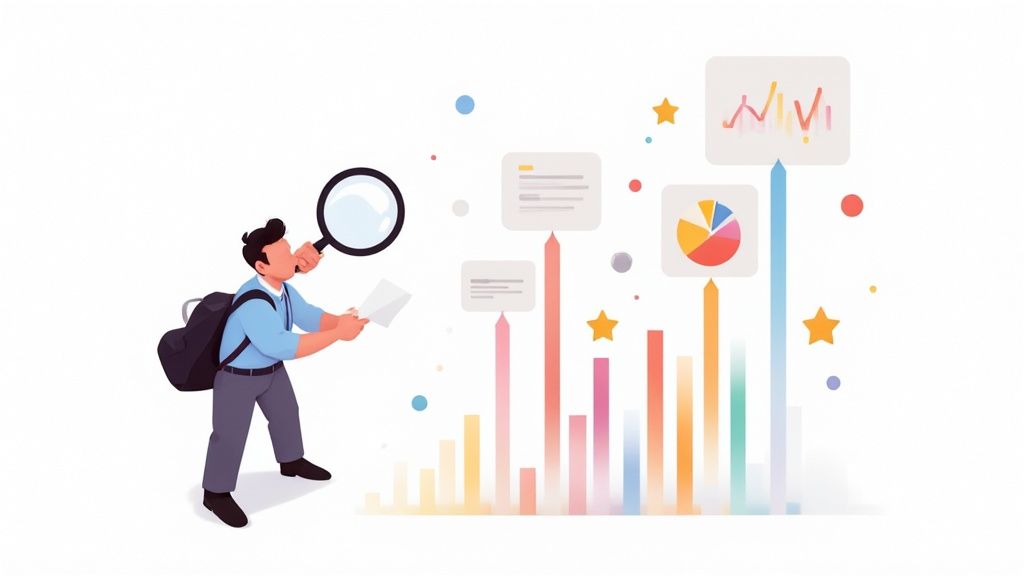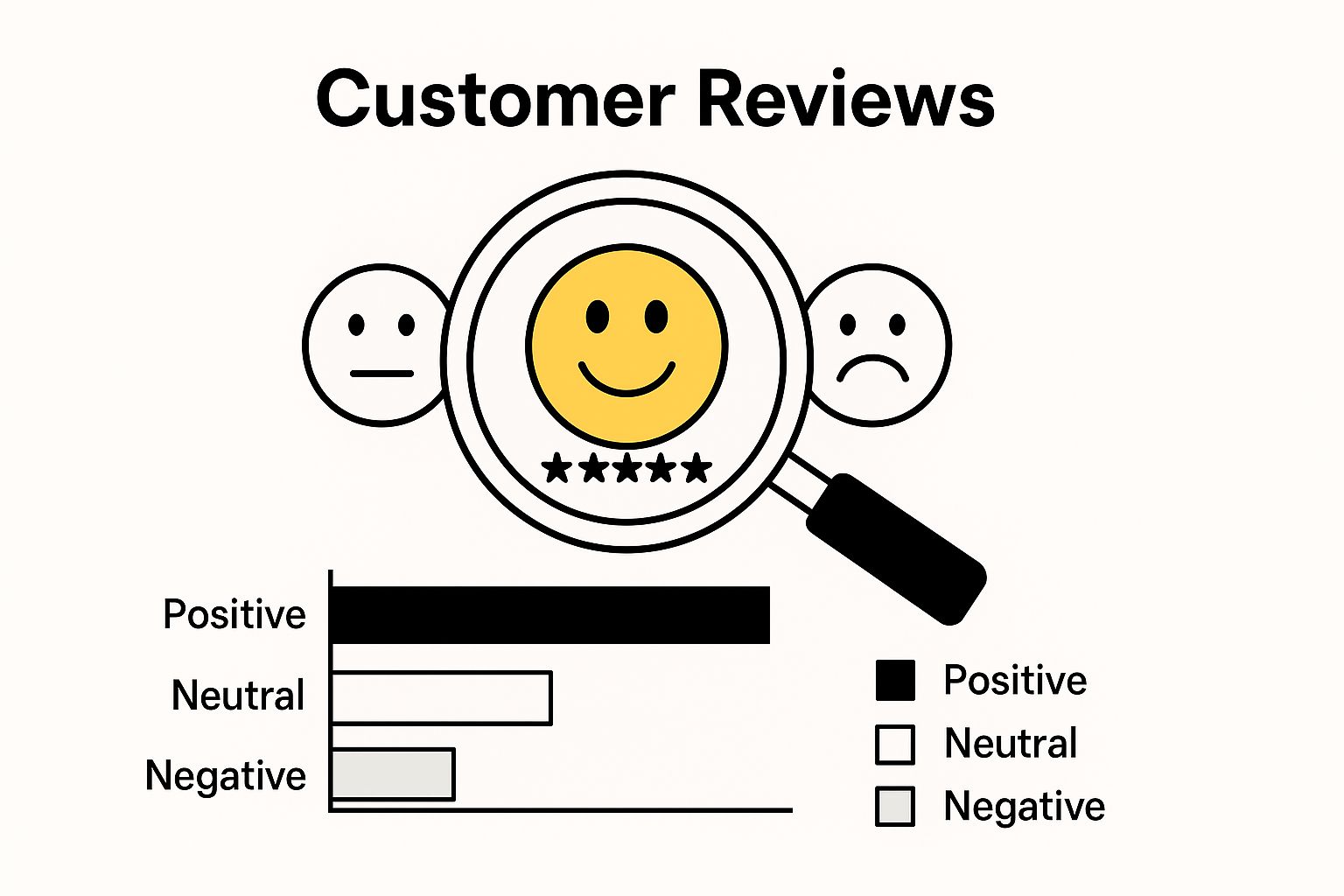Learn How to Analyze Customer Feedback Effectively
Discover proven methods to analyze customer feedback and turn insights into business growth. Start leveraging customer voices today!

Why Customer Feedback Analysis Drives Business Transformation
Analyzing customer feedback is essential for modern businesses. By carefully examining this feedback, companies gain valuable insights into their customers' needs, frustrations, and desires. This direct line of communication provides information that quantitative data often misses, allowing businesses to better understand their target audience.
This deeper understanding allows companies to adapt and evolve their operations. Ultimately, it enables them to better serve their customers and build stronger relationships. This focus on the customer experience translates into real, measurable competitive advantages.
The Impact of Actionable Insights
Imagine a software company receiving feedback about a complicated user interface. Through careful analysis, they can identify the specific pain points users are experiencing. This allows them to redesign the interface for greater usability and intuitiveness. This seemingly small change, driven directly by customer feedback, can dramatically improve user satisfaction and reduce churn.
Analyzing customer feedback can also reveal unmet customer needs. This can spark innovation, leading to the development of new product features or even entirely new product lines. Want to learn more about the importance of user feedback? Check out this helpful article: Reasons to Collect User Feedback.
The Shifting Landscape of Feedback
Traditional methods of feedback collection, like surveys and social media posts, are seeing a decline in participation. Only 16% of consumers use social media to voice complaints, a decrease from 22.9% in 2021. Similarly, only 22% of consumers write reviews on third-party sites, down from 26.2% in 2021. Find more detailed statistics here.
This shift requires businesses to adopt more sophisticated approaches to capturing customer feedback. They need to analyze data from multiple sources, like website behavior and customer service interactions. This broader perspective allows for a more complete understanding of the customer journey.
To help illustrate the power of customer feedback, let's take a look at a comparison of traditional and modern feedback collection methods:
The following table outlines the key differences and similarities between these approaches. It will help you understand the evolution of feedback collection and the benefits of modern methods.
Traditional vs. Modern Feedback Collection Methods
| Method Type | Examples | Average Response Rate | Implementation Complexity | Data Quality |
|---|---|---|---|---|
| Traditional | Surveys, Focus Groups, Social Media Posts | Low (often less than 10% for surveys) | Relatively simple | Can be biased, limited in scope |
| Modern | Website analytics, Customer Support interactions, In-app feedback, Saylo | Higher (can reach 30% or more with targeted in-app prompts) | More complex, requires integration with multiple systems | More granular, contextual, and actionable |
This table highlights the evolving nature of feedback collection. While traditional methods offer a basic level of insight, modern approaches provide richer, more actionable data.
Leveraging Feedback for Success
Tools like testimonial.to's Case Study Generator can help showcase success stories derived from customer feedback. Sharing these stories can effectively demonstrate how valuable customer insights can lead to significant business improvements. By illustrating these tangible benefits, companies can justify the investment in comprehensive feedback programs. This commitment to understanding and acting upon customer feedback drives meaningful business transformation and ensures long-term success.
Capturing Meaningful Feedback When Customers Won't Talk

Getting customers to share their opinions is harder than ever. Traditional methods, like surveys, often result in low response rates. This pushes businesses to find more engaging and proactive ways to gather and analyze customer feedback.
Rethinking Traditional Methods
Surveys still have their place, but they need a modern update. Instead of long questionnaires, keep them short, sweet, and respectful of customers' time. Consider contextual interviews, conducted right after an interaction.
For example, a quick pop-up survey after an online purchase is more likely to get a response than a generic email survey sent days later. This immediate feedback offers valuable context and increases the chance of getting helpful information.
Embracing Indirect Feedback Channels
Sometimes, the most valuable insights aren't directly spoken. Behavioral analytics, which tracks customer interactions on your website or app, can reveal a lot. Learning how customers navigate your platform can highlight pain points and areas for improvement. Customer Feedback Importance underscores why understanding this feedback is so crucial.
Conversation mining, analyzing customer service interactions, can uncover common problems and overall sentiment. Digital experience tracking tools, like Hotjar, also help by monitoring user sessions to identify friction points, providing a wealth of implicit feedback.
Building a Comprehensive Ecosystem
The best strategy blends direct and indirect feedback methods. This creates a complete customer insight ecosystem for a holistic view of the customer experience. Analyzing feedback from multiple touchpoints gives a deeper understanding of customer needs and preferences.
For example, combining website analytics with survey results might reveal why customers abandon their online shopping carts. This leads to targeted improvements and, ultimately, better conversion rates. Gathering insights from various sources helps companies understand customer behavior and improve their offerings. For more on these changing consumer trends, explore this topic further. This proactive approach helps businesses stay ahead of the curve and provide excellent customer experiences.
AI-Powered Tools That Transform Feedback Into Intelligence

The infographic above illustrates how AI can analyze customer reviews and categorize them by sentiment (positive, neutral, and negative). This automated process helps businesses quickly identify important themes and trends in customer feedback. Gaining these insights leads to a better understanding of customer sentiment, allowing businesses to focus on improvements and enhance the customer experience.
Businesses are using AI to get more from their customer feedback than ever before. Instead of relying on simple keyword searches, modern tools use Natural Language Processing (NLP) and machine learning. This allows them to understand the complexities of human language and accurately gauge customer sentiment.
Text Analytics Platforms
Text analytics platforms break down text data to find key themes, trends, and topics. These platforms go beyond simply counting words; they reveal hidden patterns and relationships within the text. For example, they can group similar feedback together, even if customers use different words to express the same sentiment. Understanding the why behind customer sentiment is crucial for businesses.
Sentiment Analysis Engines
Sentiment analysis engines are specialized tools that determine the emotional tone of text. They classify feedback as positive, negative, or neutral. Modern sentiment analysis engines can even identify more nuanced emotions like frustration, excitement, or anger. This deeper level of analysis allows for a much more precise understanding of how customers feel.
Conversation Intelligence Tools
Conversation intelligence tools analyze customer conversations from multiple sources, such as support chats, emails, and phone calls. These tools automatically identify common issues, recurring complaints, and areas for improvement in customer service. By pinpointing friction points in the customer journey, businesses can take action to improve the customer experience.
Integrated Feedback Management Systems
Integrated feedback management systems bring all your feedback data, from various sources, into a single platform. This eliminates manual data aggregation and provides a comprehensive view of the customer experience. These systems often include workflow features to efficiently route and manage feedback. For a deeper dive into how AI is changing the game, check out this insightful article: How AI Can Transform Customer Feedback Analysis With Case Studies.
The Human Element
While AI is a powerful tool, it doesn't replace human interpretation. Combining AI-driven analysis with human review offers the most accurate and actionable insights. Humans can provide valuable context to the findings of AI, adding a layer of understanding that AI currently lacks. Customer feedback analysis shows us just how important AI is becoming for customer service. A significant 77% of CRM leaders predict AI will handle most ticket resolutions by 2025, streamlining customer support. What's more, 50% of businesses say AI helps them offer 24/7 customer support, 45% see time savings, and 44% resolve problems faster. Here you'll find more detailed statistics on this topic. The most effective approach uses both human intelligence and artificial intelligence to transform raw feedback into valuable business intelligence.
The following table compares several leading AI-powered feedback analysis tools, highlighting their key features, sentiment analysis accuracy, integration capabilities, pricing, and ideal use cases. This comparison aims to help businesses choose the right tool for their specific needs.
| AI-Powered Feedback Analysis Tools Comparison |
|---|
| Tool |
| --- |
| Saylo |
| MonkeyLearn |
| Qualtrics |
| Brand24 |
| HubSpot Service Hub |
This table provides a glimpse into the diverse landscape of AI-powered feedback analysis tools. As you can see, the available options cater to a wide range of business needs and budgets. Choosing the right tool depends on your specific requirements and desired level of analysis.
Converting Raw Feedback Into Revenue-Driving Insights
Collecting customer feedback is important, but truly successful businesses know how to transform that feedback into actionable strategies. This is the key to unlocking real growth. This section dives into how to move past surface-level analysis and uncover insights that drive meaningful change.
Identifying Patterns and Prioritizing Issues
Analyzing feedback effectively involves spotting recurring themes and patterns across different sources. Think of it as piecing together a puzzle. Every comment, survey response, review, and customer service interaction contributes to a complete picture of the customer experience.
For example, if several customers report slow website loading times, it's a clear indicator of a problem that needs investigation. Prioritizing these issues based on their potential impact on the business is essential, rather than simply focusing on the number of complaints. One complaint about a security flaw, while rare, holds far more weight than many complaints about a minor interface issue.
Connecting Qualitative and Quantitative Data
Combining qualitative feedback (the "what" – such as comments and reviews) with quantitative data (the "how much" – such as star ratings and metrics) is vital. Sentiment analysis tools can help determine the general tone of customer feedback, but the true value lies in understanding the reasons behind the sentiment.
For instance, a high volume of negative feedback centered around "difficult to use" suggests the need for improvements to the user experience (UX). Linking this qualitative data with quantitative metrics, like a high bounce rate on particular web pages, provides stronger evidence and helps direct action.
Building an Insight Repository
Creating an insight repository is a cornerstone of long-term success. This centralized system stores, organizes, and allows access to all customer feedback data and the subsequent analysis. It’s like a company’s memory bank for customer insights, facilitating learning and preventing past missteps from recurring.
This repository should track feedback over time, enabling you to observe how customer sentiment shifts and how your responses affect customer satisfaction. Tools like Saylo help centralize and efficiently manage this process, turning feedback analysis from a one-time activity into a continuous improvement cycle.
Transforming Feedback Analysis into a Competitive Advantage
Regularly analyzing customer feedback gives businesses a significant competitive edge. It allows them to identify emerging trends, anticipate customer needs, and proactively address problems. This proactive approach leads to several key benefits:
Improved Product Development: Feedback provides invaluable input for designing and developing features customers genuinely want.
Enhanced Customer Experience: Addressing customer pain points revealed through feedback boosts satisfaction and fosters loyalty.
Increased Revenue: A better product and an enhanced customer experience naturally lead to improved sales and profitability.
By integrating feedback analysis into strategic decision-making, businesses can foster a customer-centric culture, driving continuous improvement and achieving sustainable growth.
Closing the Feedback Loop: From Insights to Implementation

Analyzing customer feedback is only half the journey. The true power lies in transforming these insights into tangible actions. This involves establishing a closed-loop feedback system, a continuous cycle of gathering, analyzing, implementing, and measuring the effects of changes based on customer input. This ensures that feedback actively shapes the business.
Prioritizing Actionable Feedback
Not all feedback demands immediate attention. Some feedback offers quick wins, while others require more extensive planning and resources. A practical approach involves categorizing feedback based on its potential impact and urgency.
For instance, urgent bug reports affecting core functionality need immediate action. Feature requests, while valuable, might be scheduled for later stages of development. A clear prioritization framework ensures the most impactful changes are implemented first, maximizing efficiency and improving the customer experience.
Implementing Changes and Setting Timelines
Prioritized feedback requires clear ownership. Assigning tasks to specific teams or individuals ensures accountability and efficient implementation, preventing valuable insights from being overlooked.
Realistic timelines are essential. Balancing the urgency of customer needs with the quality of implementation prevents rushed, ineffective changes. Setting clear expectations with customers about timelines builds trust and transparency.
Measuring the Impact of Feedback-Driven Initiatives
Implementation is only one part of the closed-loop process. Measuring the impact of feedback-driven changes is equally critical. Tracking key metrics related to customer satisfaction, product usage, and business outcomes demonstrates the value of the feedback process.
This data-driven approach not only validates the effectiveness of changes but also highlights areas for further improvement. Continuous monitoring and analysis ensures the feedback loop stays active and adapts to evolving customer needs. Integrating AI can improve efficiency and enhance the customer experience by providing prompt resolutions. However, a surprising 23% of CRM leaders don't utilize AI, potentially impacting resolution times and customer satisfaction. Learn more about AI in CRM.
Communicating With Customers
Effective communication is key to closing the feedback loop. Keeping customers informed about how their feedback is being addressed shows that their input is valued, strengthening customer relationships and encouraging future feedback.
Even if immediate changes aren't feasible, acknowledging feedback and explaining the reasoning behind decisions builds understanding and trust. Proactive communication manages expectations and demonstrates a commitment to continuous improvement. For more insights on feedback analysis, check out this helpful resource: Customer Feedback Analysis: Importance, Tips, and Examples for Product Improvement.
By diligently closing the feedback loop, organizations demonstrate a genuine customer-centric approach. This iterative process of listening, acting, and measuring fosters continuous improvement, builds customer loyalty, and ultimately drives business growth.
Customer Feedback Analysis That Transformed Businesses
Analyzing customer feedback is crucial. But its real value lies in how it's used to create positive change. This section explores case studies of businesses that used feedback analysis to achieve significant improvements. These stories demonstrate the path from initial feedback challenges to impactful business outcomes.
From Challenges To Triumph: Real-World Success Stories
Case Study 1: A Struggling SaaS Company. This B2B SaaS company faced high churn rates. By analyzing customer exit surveys and support tickets, they identified a recurring problem: users struggled with the onboarding process. They simplified the onboarding experience with personalized guidance and interactive tutorials. The result? A 30% reduction in churn within six months.
Case Study 2: An E-Commerce Retailer Battling Negative Reviews. This online retailer was overwhelmed with negative product reviews citing slow shipping. Through sentiment analysis and topic modeling of customer feedback, they identified logistical bottlenecks. They optimized warehouse operations and partnered with a new shipping provider, significantly reducing shipping times. This led to a 20% increase in positive reviews and a boost in sales.
Case Study 3: A Restaurant Chain Responding to Evolving Customer Preferences. This restaurant chain experienced declining foot traffic. They used in-app surveys, social media monitoring, and online review analysis to identify a growing demand for healthier menu options and online ordering. Implementing these changes revitalized their brand, attracting new customers and increasing revenue by 15%. For more on responding to negative feedback, check out this article: How to Respond to Product Negative Feedback and Improve Customer Satisfaction.
Key Takeaways From Successful Feedback Implementations
These case studies reveal several important factors:
The Importance of a Holistic Approach: Combining multiple feedback channels (surveys, reviews, support interactions) offers a comprehensive view of customer needs.
Actionable Insights Over Data Overload: Prioritizing key themes and focusing on business impact is more effective than simply collecting large amounts of data.
The Power of Iteration: Continuously monitoring and analyzing feedback, combined with iterative improvements, creates lasting positive change.
Overcoming Obstacles and Embracing Change
These success stories weren't easy. Many companies initially faced challenges with data silos, inefficient analysis processes, and internal resistance to change. The businesses that succeeded integrated feedback analysis as an ongoing process, creating a customer-centric culture. This commitment to continuous improvement ultimately drove transformative results.
Ready to transform your product development with a customer-centric approach? Discover the power of Saylo, the all-in-one platform for feedback management, roadmapping, and communication. Centralize your feedback, prioritize features based on user needs, and keep your customers informed.